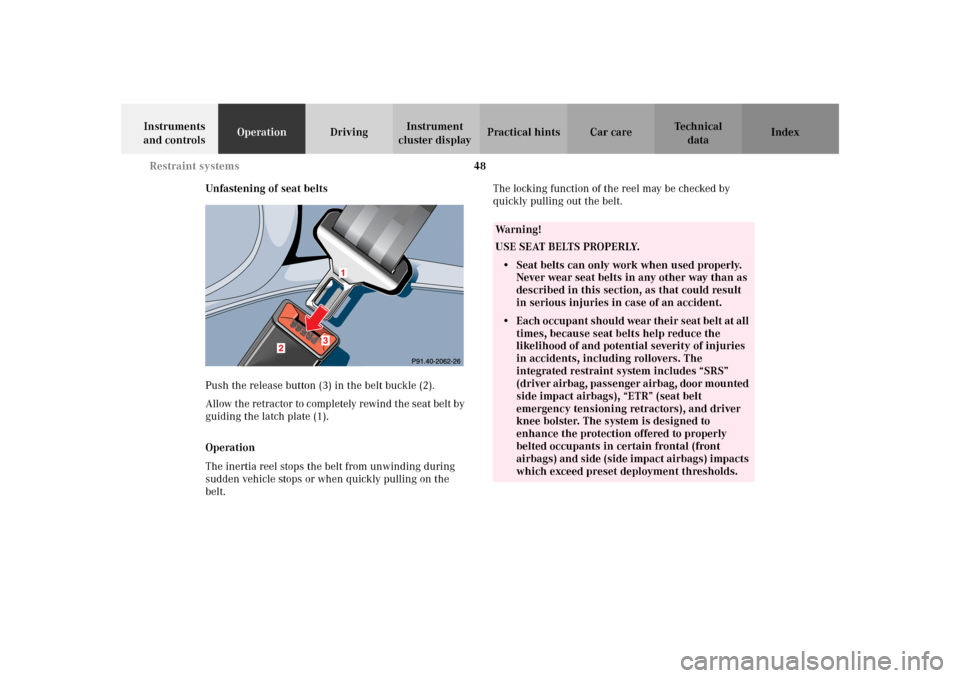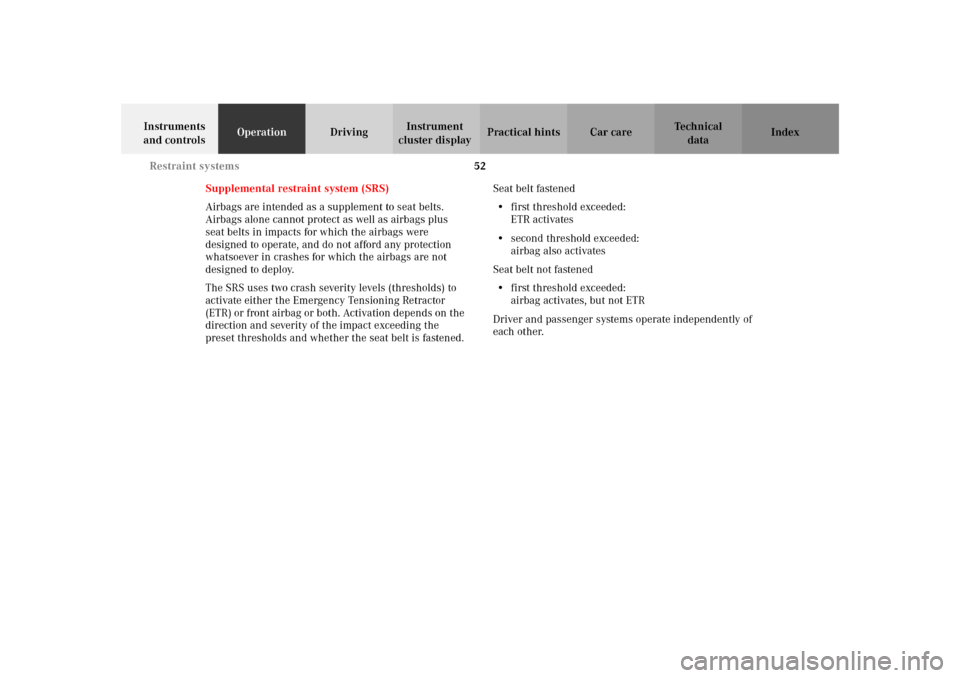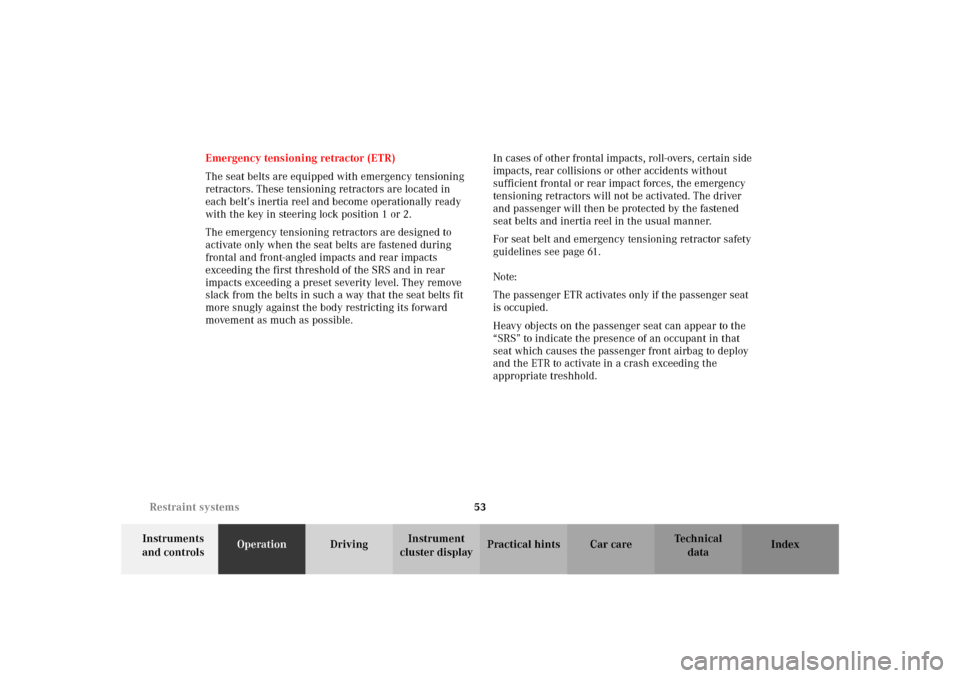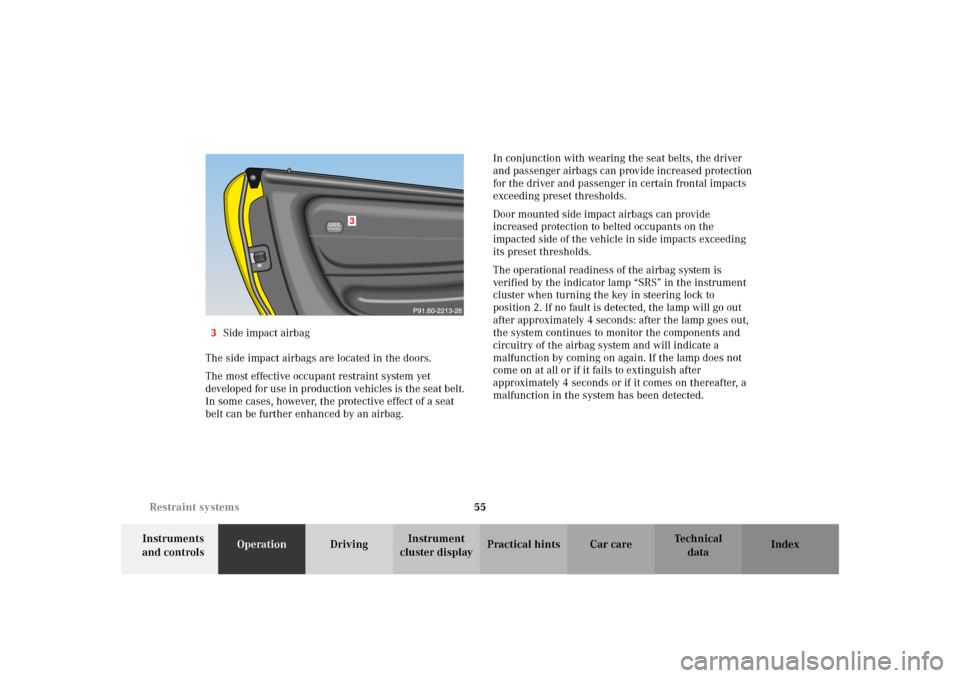2002 MERCEDES-BENZ SLK 230 KOMPRESSOR srs
[x] Cancel search: srsPage 4 of 290

1 Contents
IntroductionProduct information .......................... 5
Operator’s manual ............................. 6
Where to find it ................................ 11
Reporting Safety Defects ................ 13Instruments and controlsInstruments and controls ............... 16
Center console .............................. 18
Overhead control panel ............... 19OperationVehicle keys ...................................... 22
Remote control with
folding master key ...................... 22
Start lock-out .................................... 23
General notes on the
central locking system ............... 23
Central locking system ................... 24
Remote control ............................. 24
Panic button .................................. 26
Mechanical keys ........................... 27Doors ................................................. 28
Central locking switch .................... 30
Automatic central locking ...............31
Emergency unlocking in
case of accident .......................... 32
Trunk ................................................. 33
Emergency release
for trunk lid ................................. 35
Antitheft alarm system ................... 35
Tow-away alarm ............................... 37
Seats .................................................. 38
Seat heater ........................................ 42
Seat belts and
integrated restraint system ....... 44
Seat belts .......................................... 44
Seat belt nonusage
warning system ............................ 45
BabySmart
TM airbag
deactivation system ....................51
Self-test BabySmart
TM without
special child seat installed ..........51
Supplemental restraint system
(SRS) ............................................. 52Emergency tensioning retractor
(ETR) ............................................. 53
Airbags .............................................. 54
Safety guidelines for the
seat belt, emergency
tensioning retractor
and airbag .................................... 61
Infant and
child restraint systems ............... 63
Adjusting telescoping
steering column .......................... 65
Rear view mirrors ............................ 66
Instrument cluster ........................... 70
Flexible service system (FSS) ........ 77
Checking engine oil level .............. 79
Engine oil consumption .................. 80
Exterior lamp switch ....................... 81
Headlamp cleaning system ............ 82
Combination switch ........................ 83
Hazard warning flasher switch ..... 85
Climate control ................................. 86
Rear window defroster .................... 90
Audio and telephone, operation .... 93
Power windows ................................ 111
Page 6 of 290

3 ContentsSupplemental restraint system
(SRS) indicator lamp .................. 184
Fuel reserve and fuel cap
placement warning .................... 185
Electronic stability program
(ESP) — warning lamp ............... 185
BAS / ESP malfunction
indicator lamp ............................. 185
ABS malfunction
indicator lamp ............................. 186
Telescoping steering column
warning lamp .............................. 186
Low engine coolant level
warning lamp .............................. 187
Low windshield and headlamp
washer system fluid level
warning lamp .............................. 187
Low engine oil level
warning lamp .............................. 188
Charge indicator lamp ............... 188
Exterior lamp failure i
ndicator lamp .............................. 189
Additional function
indicator lamps
(in the odometer display) .......... 189Malfunction and indicator lamp
in the center console ................190
AIRBAG OFF indicator lamp .....190
Practical hintsFirst aid kit ......................................192
Stowing items in the vehicle ........192
Fuses ................................................192
Hood .................................................194
Automatic transmission
fluid level ....................................196
Checking engine oil level ..............197
Coolant level ....................................198
Adding coolant ............................198
Windshield and
headlamp washer system .........199
Air pump, spare wheel,
vehicle tools,
storage compartment
(except SLK 32 AMG) .............. 200
Ve h i c l e j a c k
(except SLK 32 AMG) .............. 201Storage box, TIREFIT-Kit,
air pump, Vehicle tools
(SLK 32 AMG only) ...................202
Wheels .............................................203
Tire replacement ........................203
Rotating wheels ..........................204
Spare wheel ....................................205
Spare wheel bolts .......................206
Changing wheels ...........................207
Inflating the collapsible
spare tire ..................................... 212
Storing spare wheel in
wheel well ................................... 213
TIREFIT ........................................... 214
Tire inflation pressure .................. 219
Battery .............................................220
Jump starting ..................................222
Towing the vehicle .........................224
Transmission selector lever,
manually unlocking ..................229
Exterior lamps ................................230
Headlamp assembly ................... 231
Taillamp assemblies ..................234
Page 23 of 290

20 Contents - Operation
Te ch n i c a l
data Instruments
and controlsOperationDrivingInstrument
cluster displayPractical hints Car care Index
OperationVehicle keys ...................................... 22
Remote control with
folding master key ...................... 22
Start lock-out .................................... 23
General notes on the
central locking system ............... 23
Central locking system ................... 24
Remote control ............................. 24
Panic button .................................. 26
Mechanical keys ........................... 27
Doors .................................................. 28
Central locking switch .................... 30
Automatic central locking .............. 31
Emergency unlocking in
case of accident ........................... 32
Trunk ................................................. 33Emergency release
for trunk lid ................................. 35
Antitheft alarm system ................... 35
Tow-away alarm ............................... 37
Seats .................................................. 38
Seat heater ........................................ 42
Seat belts and
integrated restraint system ....... 44
Seat belts .......................................... 44
Seat belt nonusage
warning system ............................ 45
BabySmart
TM airbag
deactivation system ....................51
Self-test BabySmart
TM without
special child seat installed ..........51
Supplemental restraint system
(SRS) ............................................. 52
Emergency tensioning retractor
(ETR) ............................................. 53Airbags .............................................. 54
Safety guidelines for the
seat belt, emergency
tensioning retractor
and airbag .................................... 61
Infant and
child restraint systems ............... 63
Adjusting telescoping
steering column .......................... 65
Rear view mirrors ............................ 66
Instrument cluster ........................... 70
Flexible service system (FSS) ........ 77
Checking engine oil level .............. 79
Engine oil consumption .................. 80
Exterior lamp switch ....................... 81
Headlamp cleaning system ............ 82
Combination switch ........................ 83
Hazard warning flasher switch ..... 85
Climate control ................................. 86
Page 51 of 290

48 Restraint systems
Te ch n i c a l
data Instruments
and controlsOperationDrivingInstrument
cluster displayPractical hints Car care Index
Unfastening of seat belts
Push the release button (3) in the belt buckle (2).
Allow t he retractor to completely rewind t he seat belt by
guiding the latch plate (1).
Operation
The inertia reel stops the belt from unwinding during
sudden vehicle stops or when quickly pulling on the
belt.The locking function of the reel may be checked by
quickly pulling out the belt.
Wa r n i n g !
USE SEAT BELTS PROPERLY.• Seat belts can only work when used properly.
Never wear seat belts in any other way than as
described in this section, as that could result
in serious injuries in case of an accident.• Each occupant should wear their seat belt at all
times, because seat belts help reduce the
likelihood of and potential severity of injuries
in accidents, including rollovers. The
integrated restraint system includes “SRS”
(driver airbag, passenger airbag, door mounted
side impact airbags), “ETR” (seat belt
emergency tensioning retractors), and driver
knee bolster. The system is designed to
enhance the protection offered to properly
belted occupants in certain frontal (front
airbags) and side (side impact airbags) impacts
which exceed preset deployment thresholds.
Page 55 of 290

52 Restraint systems
Te ch n i c a l
data Instruments
and controlsOperationDrivingInstrument
cluster displayPractical hints Car care Index
Supplemental restraint system (SRS)
Airbags are intended as a supplement to seat belts.
Airbags alone cannot protect as well as airbags plus
seat belts in impacts for which the airbags were
designed to operate, and do not afford any protection
whatsoever in crashes for which the airbags are not
designed to deploy.
The SRS uses two crash severity levels (thresholds) to
activate either the Emergency Tensioning Retractor
(ETR) or front airbag or both. Activation depends on the
direction and severity of the impact exceeding the
preset thresholds and whether the seat belt is fastened.Seat belt fastened
•first threshold exceeded:
ETR activates
•second threshold exceeded:
airbag also activates
Seat belt not fastened
•first threshold exceeded:
airbag activates, but not ETR
Driver and passenger systems operate independently of
each other.
Page 56 of 290

53 Restraint systems
Te ch n i c a l
data Instruments
and controlsOperationDrivingInstrument
cluster displayPractical hints Car care Index Emergency tensioning retractor (ETR)
The seat belts are equipped with emergency tensioning
retractors. These tensioning retractors are located in
each belt’s inertia reel and become operationally ready
with the key in steering lock position 1 or 2.
The emergency tensioning retractors are designed to
activate only when the seat belts are fastened during
frontal and front-angled impacts and rear impacts
exceeding the first threshold of the SRS and in rear
impacts exceeding a preset severity level. They remove
slack from the belts in such a way that the seat belts fit
more snugly against the body restricting its forward
movement as much as possible.In cases of other frontal impacts, roll-overs, certain side
impacts, rear collisions or other accidents without
sufficient frontal or rear impact forces, the emergency
tensioning retractors will not be activated. The driver
and passenger will then be protected by the fastened
seat belts and inertia reel in the usual manner.
For seat belt and emergency tensioning retractor safety
guidelines see page 61.
Note:
The passenger ETR activates only if the passenger seat
is occupied.
Heavy objects on the passenger seat can appear to the
“SRS” to indicate the presence of an occupant in that
seat which causes the passenger front airbag to deploy
and the ETR to activate in a crash exceeding the
appropriate treshhold.
Page 58 of 290

55 Restraint systems
Te ch n i c a l
data Instruments
and controlsOperationDrivingInstrument
cluster displayPractical hints Car care Index 3Side impact airbag
The side impact airbags are located in the doors.
The most effective occupant restraint system yet
developed for use in production vehicles is the seat belt.
In some cases, however, the protective effect of a seat
belt can be further enhanced by an airbag.In conjunction with wearing the seat belts, the driver
and passenger airbags can provide increased protection
for the driver and passenger in certain frontal impacts
exceeding preset thresholds.
Door mounted side impact airbags can provide
increased protection to belted occupants on the
impacted side of the vehicle in side impacts exceeding
its preset thresholds.
The operational readiness of the airbag system is
verified by the indicator lamp “SRS” in the instrument
cluster when turning the key in steering lock to
position 2. If no fault is detected, the lamp will go out
after approximately 4 seconds: after the lamp goes out,
the system continues to monitor the components and
circuitry of the airbag system and will indicate a
malfunction by coming on again. If the lamp does not
come on at all or if it fails to extinguish after
approximately 4 seconds or if it comes on thereafter, a
malfunction in the system has been detected.
Page 59 of 290

56 Restraint systems
Te ch n i c a l
data Instruments
and controlsOperationDrivingInstrument
cluster displayPractical hints Car care Index
The following system components are monitored or
undergo a selfcheck: crash-sensor(s), airbag ignition
circuits, seat belt buckles, emergency tensioning
retractors, seat sensor.
Initially, when the key is turned from steering lock
position 0 to positions 1 or 2, malfunctions in the crash-
sensor are detected and indicated (the “SRS” indicator
lamp stays on longer than 4 seconds or does not come
on). In the operational mode, after the indicator lamp
has gone out following the initial check, interruptions or
short circuits in the airbag ignition circuit and in the
driver and passenger seat belt buckle harnesses, and
low voltage in the entire system are detected and
indicated.
Have the system checked at your authorized
Mercedes-Benz Center immediately.
Wa r n i n g !
In the event a malfunction of the “SRS” is indicated
as outlined above, the “SRS” may not be
operational. For your safety, we strongly
recommend that you visit an authorized Mercedes-
Benz Center immediately to have the system
checked; otherwise the “SRS” may not be activated
when needed in an accident, which could result in
serious or fatal injury, or it might deploy
unexpectedly and unnecessary which could also
result in injury.